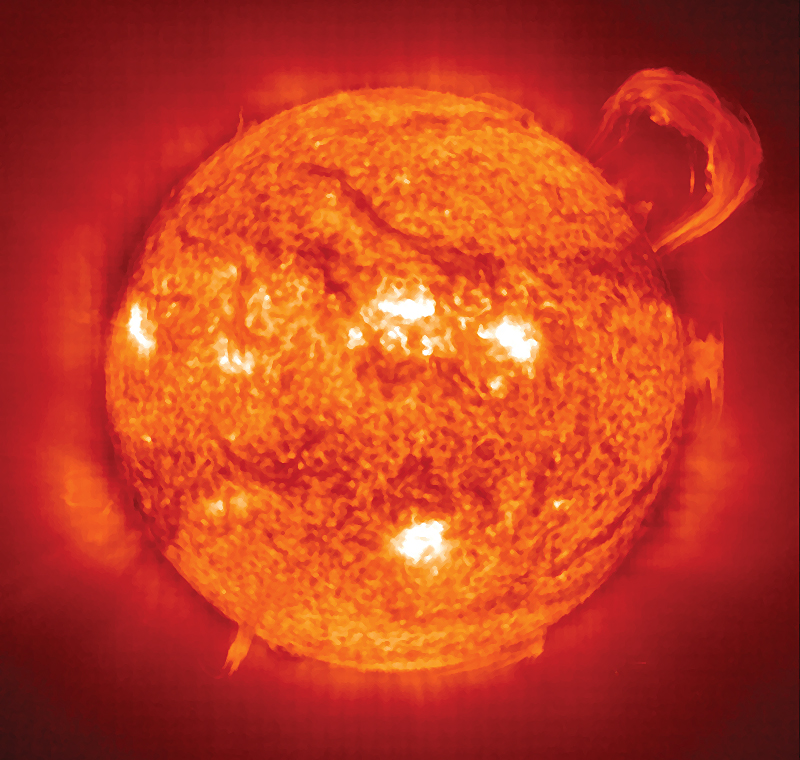
Behavior Prediction Tools Strengthen Nanoelectronics
NASA Technology
Several years ago, NASA started making plans to send robots to explore the deep, dark craters on the Moon. As part of these plans, NASA needed modeling tools to help engineer unique electronics to withstand extremely cold temperatures.
According to Jonathan Pellish, a flight systems test engineer at Goddard Space Flight Center, “An instrument sitting in a shadowed crater on one of the Moon’s poles would hover around 43 K”—that is, 43 kelvin, equivalent to -382 °F. Such frigid temperatures are one of the main factors that make the extreme space environments encountered on the Moon and elsewhere so extreme.
Radiation is another main concern.
“Radiation is always present in the space environment,” says Pellish. “Small to moderate solar energetic particle events happen regularly and extreme events happen less than a handful of times throughout the 7 active years of the 11-year solar cycle.” Radiation can corrupt data, propagate to other systems, require component power cycling, and cause a host of other harmful effects.
In order to explore places like the Moon, Jupiter, Saturn, Venus, and Mars, NASA must use electronic communication devices like transmitters and receivers and data collection devices like infrared cameras that can resist the effects of extreme temperature and radiation; otherwise, the electronics would not be reliable for the duration of the mission.
Technology Transfer
Since 1987, NASA has partnered with Huntsville, Alabama-based CFD Research Corporation (CFDRC), a company that specializes in engineering simulations and innovative designs and prototypes for aerospace and other industries. A few years ago, CFDRC received funding from Marshall Space Flight Center’s Small Business Innovation Research (SBIR) program to refine an existing software tool to predict the behavior of electronics in the cold, radiation-filled environment of space.
During the first phase of its work, in collaboration with Georgia Tech, CFDRC enhanced and demonstrated a technology called NanoTCAD for predicting the response of silicon-germanium (SiGe) semiconductor technology to radiation. During its second phase, the company demonstrated and validated NanoTCAD for temperature ranges from -382–266 °F.
Marek Turowski, the director of the nanoelectronic and plasma technology group at CFDRC explains how, as electronic parts become smaller, the effects of radiation and temperature become more severe. “When radiation particles bombard a microchip, it is like hail hitting a car,” he says.
Even though hail may not damage a large truck, the same hail could cause significant damage to a truck the size of a toy. Likewise, as electronic devices decrease in size, radiation particles can damage them more easily.
Being able to predict the behavior of nanoelectronics in the extreme space environment reduces the risk of failure during a critical NASA mission. Using NanoTCAD, designers can better evaluate performance and response of electronics early in the design stage, thereby reducing the costs and testing time involved. As Turowski explains it, “The purpose of NanoTCAD tools and models is to predict the behavior of electronics in space before they actually go to space. The prediction happens on the computer screen and accurately takes temperature and radiation into account.”
Pellish says NanoTCAD has already been used to evaluate key technologies for the Ice, Cloud, and land Elevation Satellite-2 (ICESat-2), scheduled for launch in 2016. ICESat-2 will look at polar ice, sea-level change, vegetation canopy height, and climate. “The NanoTCAD research on SiGe semiconductor technology processes provided a portion of the necessary insight into this technology so that it can be used in space,” he says.
Benefits
NanoTCAD software is now available from CFDRC as a nanotechnology computer aided design (CAD) tool to predict the effects of extreme thermal and radiation environments on electronic systems. It is also used by CFDRC in its modeling and simulation services provided to the aerospace industry. The “nano” part of the product’s name means the software can address nano-size devices while “TCAD” stands for “technology computer aided design.”
“It solves basic physics equations,” says Turowski. “It looks at how electrons flow, how fields inside the devices behave, and how the varying temperature affects their behavior.”
Today, CFDRC’s NanoTCAD customers include electronic chip designers at Georgia Tech and Vanderbilt University. The electronics, chips, circuits, and devices that the universities are modeling with NanoTCAD are often for NASA missions. The European Space Agency and the Japanese Aerospace Exploration Agency are also potential customers of CFDRC’s NASA-improved technology.
The tool is also being employed for Department of Defense applications for space communication and surveillance systems for satellites. Entities like the Air Force and Navy design electronics that can suffer the same problems as NASA spacecraft. CFDRC also uses NanoTCAD to provide modeling, simulations, and radiation-hardening design services to national nuclear laboratories and commercial satellite designers.
According to CFDRC, the technology has led to approximately $2 million in revenue for the company, created new jobs, and led to partnerships with other defense and industrial customers.
“NASA has given us the opportunity to develop valuable technology,” says Turowski. “Now the technology is being adapted and enhanced for every new generation of electronics.”
Whether it is for the Moon, on-orbit, or other applications, CFDRC’s work with NASA is helping to make future space missions possible.

The electronics that go to the Moon must be able to withstand extremely cold temperatures.

Activity on the Sun increases radiation in space, which can negatively affect the electronics on a spacecraft. To help reduce the risk of failure during a mission, NASA worked on software with CFD Research Corporation to predict the behavior of nanoelectronics in the extreme conditions of space.













